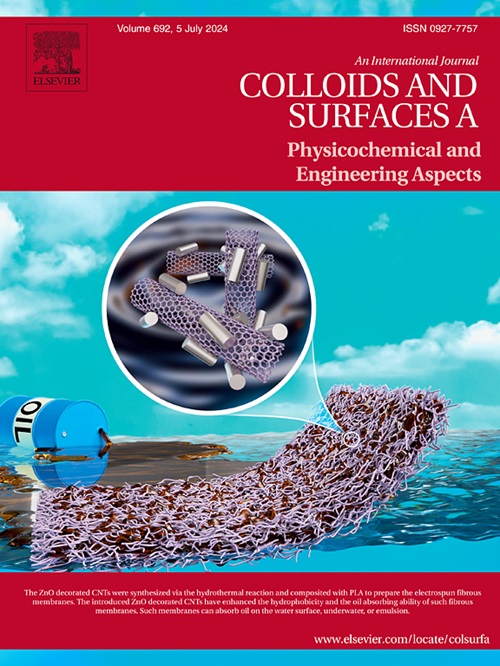Anti-cancer and anti-microbial drug encapsulated lipid vesicles as drug delivery systems: Calorimetric and spectroscopic study
IF 4.9
2区 化学
Q2 CHEMISTRY, PHYSICAL
Colloids and Surfaces A: Physicochemical and Engineering Aspects
Pub Date : 2024-11-02
DOI:10.1016/j.colsurfa.2024.135691
引用次数: 0
Abstract
Lipid-based drug delivery systems (DDS) have attracted considerable interest for their capacity to achieve controlled drug release and encapsulate a variety of drug molecules—hydrophobic, hydrophilic, and amphiphilic—enabling diverse therapeutic applications. The research focuses on the structural and functional aspects of lipid-based vesicles that encapsulate both anti-cancer and anti-microbial drugs. The study employs ultrasensitive isothermal titration calorimetry and differential scanning calorimetry to gain mechanistic insights into the partitioning of drugs in the lipid-based DDS, release mechanisms, and binding interactions with serum proteins after the release.
The structural properties of 5-fluorouracil (5-FU) suggest that the drug can partition into the outer region of the bilayer, where it forms hydrogen bonds with the polar heads of the amphiphilic lipid chains. Kanamycin indicates strong partitioning into liposomes as it displays a binding constant of the order of 106. Erythromycin exhibits limited partitioning into the bilayer, as assessed by fitting ITC data using a sequential two-binding site model. The values of change in enthalpy and entropy reflect the interaction nature and desolvation process during the drug's partitioning into liposomes. Thermodynamic signatures and transition temperatures obtained from ITC and DSC studies indicate that no diffusion-based drug release occurs from DPPC and DSPC-based liposomes. The interaction heat between the released drug and carrier serum albumin protein is very low and shows no consistent pattern. This suggests that the drugs are stably encapsulated in the drug delivery system (DDS), with no significant leakage over time. Insights from such studies on the influence of drug molecule structure on its partitioning into various lipid vesicles and further release of the same drugs from it guide in criteria for developing improvised drug delivery systems.
作为给药系统的抗癌和抗微生物药物封装脂质囊泡:量热和光谱研究
脂质给药系统(DDS)能够实现药物的可控释放,并能包裹各种药物分子--疏水性、亲水性和两亲性--从而实现多样化的治疗应用,因此备受关注。研究重点是脂基囊泡的结构和功能方面,这些囊泡可封装抗癌和抗微生物药物。研究采用超灵敏等温滴定量热法和差示扫描量热法,从机理上深入了解药物在脂基 DDS 中的分区、释放机制以及释放后与血清蛋白的结合相互作用。5-氟尿嘧啶(5-FU)的结构特性表明,该药物可以分区到双分子层的外部区域,在那里与两亲脂质链的极性头形成氢键。卡那霉素在脂质体中的结合常数为 106。红霉素在双分子层中的分配有限,这是用顺序双结合位点模型拟合 ITC 数据后得出的结果。焓和熵的变化值反映了药物分入脂质体过程中的相互作用性质和脱溶过程。从 ITC 和 DSC 研究中获得的热力学特征和转变温度表明,DPPC 和 DSPC 脂质体不会发生基于扩散的药物释放。释放出的药物与载体血清白蛋白之间的相互作用热非常低,而且没有显示出一致的模式。这表明药物被稳定地包裹在给药系统(DDS)中,随着时间的推移没有明显的泄漏。这些研究揭示了药物分子结构对其在各种脂质囊泡中的分配以及同种药物进一步释放的影响,为开发改进型给药系统提供了指导标准。
本文章由计算机程序翻译,如有差异,请以英文原文为准。
求助全文
约1分钟内获得全文
求助全文
来源期刊
CiteScore
8.70
自引率
9.60%
发文量
2421
审稿时长
56 days
期刊介绍:
Colloids and Surfaces A: Physicochemical and Engineering Aspects is an international journal devoted to the science underlying applications of colloids and interfacial phenomena.
The journal aims at publishing high quality research papers featuring new materials or new insights into the role of colloid and interface science in (for example) food, energy, minerals processing, pharmaceuticals or the environment.

 求助内容:
求助内容: 应助结果提醒方式:
应助结果提醒方式:


